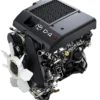Tips for avoiding common mistakes when installing an upgraded or rebuilt replacement motor in vehicles with complex electronic systems
8 Tips for avoiding common mistakes when installing an upgraded or rebuilt replacement motor in vehicles with complex electronic systems
In the world of automotive engineering, the integration of complex electronic systems has revolutionized vehicle performance. However, when it comes to installing upgraded or rebuilt replacement motors in these sophisticated machines, even the most experienced mechanics can stumble upon common pitfalls. Whether you’re a seasoned technician or a DIY enthusiast, mastering the art of installing replacement motors in vehicles with complex electronic systems is crucial. Here are some invaluable tips to avoid the most common mistakes: Tips for avoiding common mistakes when installing an upgraded or rebuilt replacement motor in vehicles with complex electronic systems
1. Thoroughly Inspect the Replacement Motor:
Before diving into the installation process, meticulously inspect the replacement motor. Look for any signs of damage, wear, or manufacturing defects. Verify that all the components, including sensors and connectors, are compatible with your vehicle’s electronic system. This step sets the foundation for a successful installation and prevents headaches down the road. Tips for avoiding common mistakes when installing an upgraded or rebuilt replacement motor in vehicles with complex electronic systems
2. Ensure Compatibility with Electronic Systems:
Modern vehicles rely heavily on intricate electronic systems to regulate various functions, from engine performance to safety features. Prior to installation, confirm that the replacement motor is compatible with your vehicle’s electronic architecture. Check for compatibility with the Engine Control Unit (ECU), Transmission Control Unit (TCU), and other critical components. Incompatible systems can lead to functionality issues and even permanent damage. Tips for avoiding common mistakes when installing an upgraded or rebuilt replacement motor in vehicles with complex electronic systems
3. Document and Label Connections:
Complex electronic systems involve numerous connectors, wires, and sensors. Before disconnecting anything, document the existing setup and label each connection meticulously. Take photographs or create diagrams to serve as reference points during reassembly. This practice minimizes the risk of errors and simplifies troubleshooting if issues arise. Tips for avoiding common mistakes when installing an upgraded or rebuilt replacement motor in vehicles with complex electronic systems
4. Follow Manufacturer Guidelines:
Whether you’re installing an OEM replacement motor or an aftermarket upgrade, adhere to the manufacturer’s guidelines religiously. Refer to the service manual, technical bulletins, and online resources provided by the manufacturer. Skipping or overlooking these instructions can lead to costly mistakes and void warranties. Tips for avoiding common mistakes when installing an upgraded or rebuilt replacement motor in vehicles with complex electronic systems
5. Calibrate Sensors and Systems:
After installing the replacement motor, it’s crucial to calibrate sensors and electronic systems to ensure optimal performance. Use diagnostic tools and software to reset adaptations, perform throttle relearn procedures, and recalibrate sensors such as Mass Air Flow (MAF) and Oxygen (O2) sensors. This step prevents drivability issues and enhances overall efficiency. Tips for avoiding common mistakes when installing an upgraded or rebuilt replacement motor in vehicles with complex electronic systems
6. Test Components and Systems:
Before declaring the installation complete, conduct comprehensive tests to verify the functionality of all components and systems. Perform a thorough diagnostic scan to check for error codes and anomalies. Test drive the vehicle under various conditions to assess performance, responsiveness, and overall drivability. Address any issues promptly to prevent further complications. Tips for avoiding common mistakes when installing an upgraded or rebuilt replacement motor in vehicles with complex electronic systems
7. Stay Updated on Technical Information:
The automotive industry is constantly evolving, with new technologies and advancements emerging regularly. Stay informed about technical updates, recalls, and service bulletins related to your vehicle’s make and model. Join online forums, attend training workshops, and engage with fellow professionals to exchange knowledge and insights. Continuous learning is key to mastering the intricacies of modern automotive systems. Tips for avoiding common mistakes when installing an upgraded or rebuilt replacement motor in vehicles with complex electronic systems
8. Seek Professional Assistance if Needed:
Installing a replacement motor in a vehicle with complex electronic systems can be daunting, especially for novices. Don’t hesitate to seek assistance from experienced professionals or certified technicians if you encounter challenges beyond your expertise. Consulting with experts ensures that the installation is done correctly and minimizes the risk of costly mistakes.
In conclusion, installing upgraded or rebuilt replacement motors in vehicles with complex electronic systems requires meticulous attention to detail, adherence to manufacturer guidelines, and a thorough understanding of modern automotive technology. By following these tips and best practices, you can navigate the installation process with confidence and ensure the optimal performance of your vehicle for years to come. Tips for avoiding common mistakes when installing an upgraded or rebuilt replacement motor in vehicles with complex electronic systems








